service indicator CHEVROLET BLAZER 1996 2.G Owners Manual
[x] Cancel search | Manufacturer: CHEVROLET, Model Year: 1996, Model line: BLAZER, Model: CHEVROLET BLAZER 1996 2.GPages: 392, PDF Size: 20.35 MB
Page 83 of 392
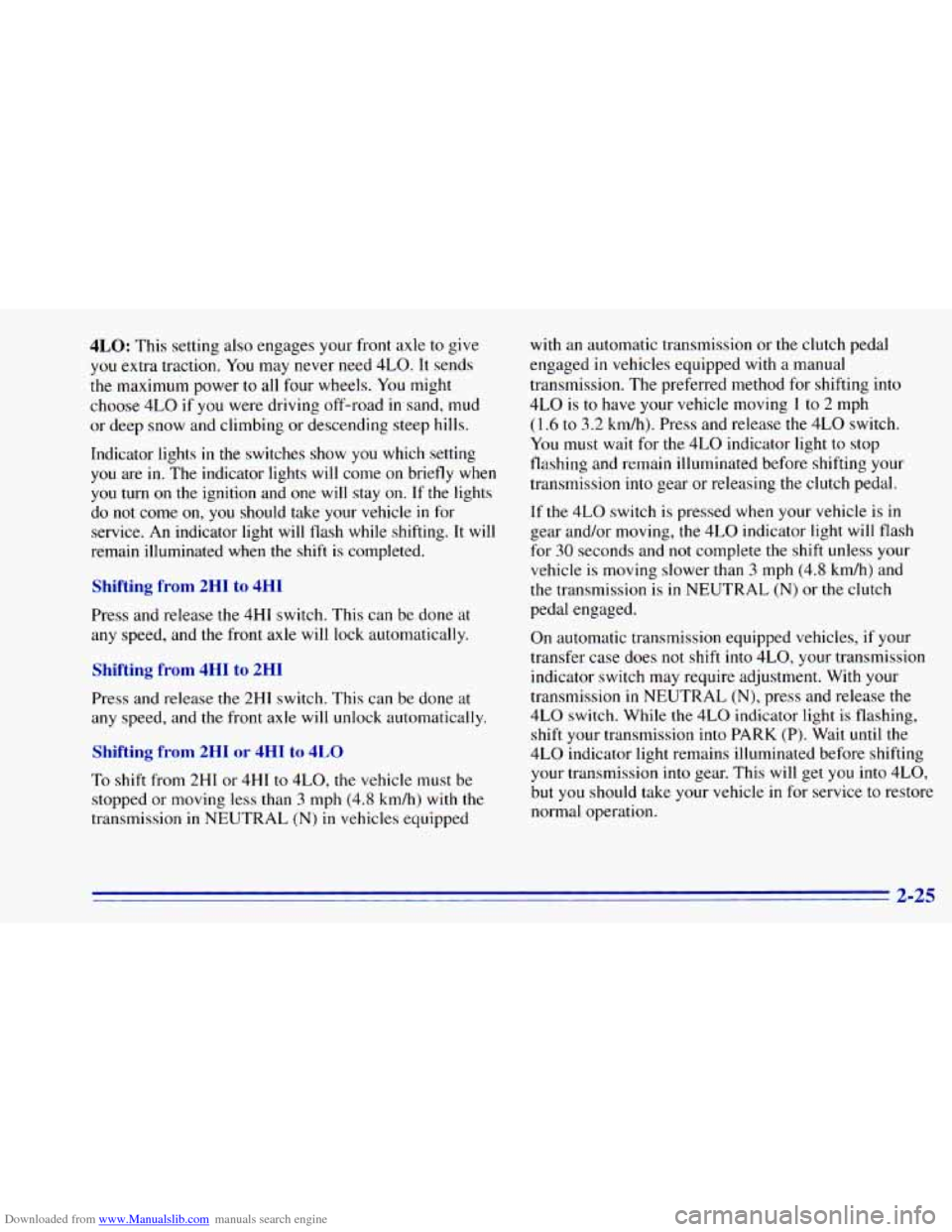
Downloaded from www.Manualslib.com manuals search engine 4LO: This setting also engages your front axle to give
you extra traction. You may never need 4LO. It sends
the maximum power to all four wheels. You might
choose 4LO
if you were driving off-road in sand, mud
or deep snow and climbing or descending steep hills.
Indicator lights
in the switches show you which setting
you are in. The indicator lights will come on briefly when
you turn
on the ignition and one will stay on. If the lights
do not come on, you should take your vehicle
in for
service. An indicator light will flash while shifting.
It will
remain illuminated when the shift is completed.
Shifting from 2HI to 4HI'
Press and release the 4HI switch. This can be done at
any speed, and the front axle will lock automatically.
Shifting from 4HI to 2HI
Press and release the 2HI switch. This can be done at
any speed, and the front axle will unlock automatically.
Shifting from 2HI or I1 to 4LO
To shift from tHI or 4HI to 4L0, the vehicle must be
stopped or moving less than
3 mph (4.8 km/h) with the
transmission
in NEUTRAL (N) in vehicles equipped with an
automatic transmission or the clutch pedal
engaged in vehicles equipped with a manual
transmission. The preferred method for shifting into
4LO is
to have your vehicle moving 1 to 2 mph
(1.6
to 3.2 km/h). Press and release the 4LO switch.
You must wait for the 4LO indicator light to stop
flashing and remain illuminated before shifting your
transmission
into gear or releasing the clutch pedal.
If the 4LO switch is pressed when your vehicle is in
gear and/or moving, the 4LO indicator light will flash
for
30 seconds and not complete the shift unless your
vehicle is moving slower than
3 mph (4.8 km/h) and
the transmission is in NEUTRAL (N) or the clutch
pedal engaged.
On automatic transmission equipped vehicles, if your
transfer case does not shift into 4L0, your transmission
indicator switch may require adjustment. With your
transmission
in NEUTRAL (N), press and release the
4LO switch. While the 4LO indicator light is flashing,
shift your transmission into PARK (P). Wait until the
4LO indicator light remains illuminated before shifting
your transmission
into gear. This will get you into 4L0,
but you should take your vehicle
in for service to restore
normal operation.
2-25
Page 84 of 392
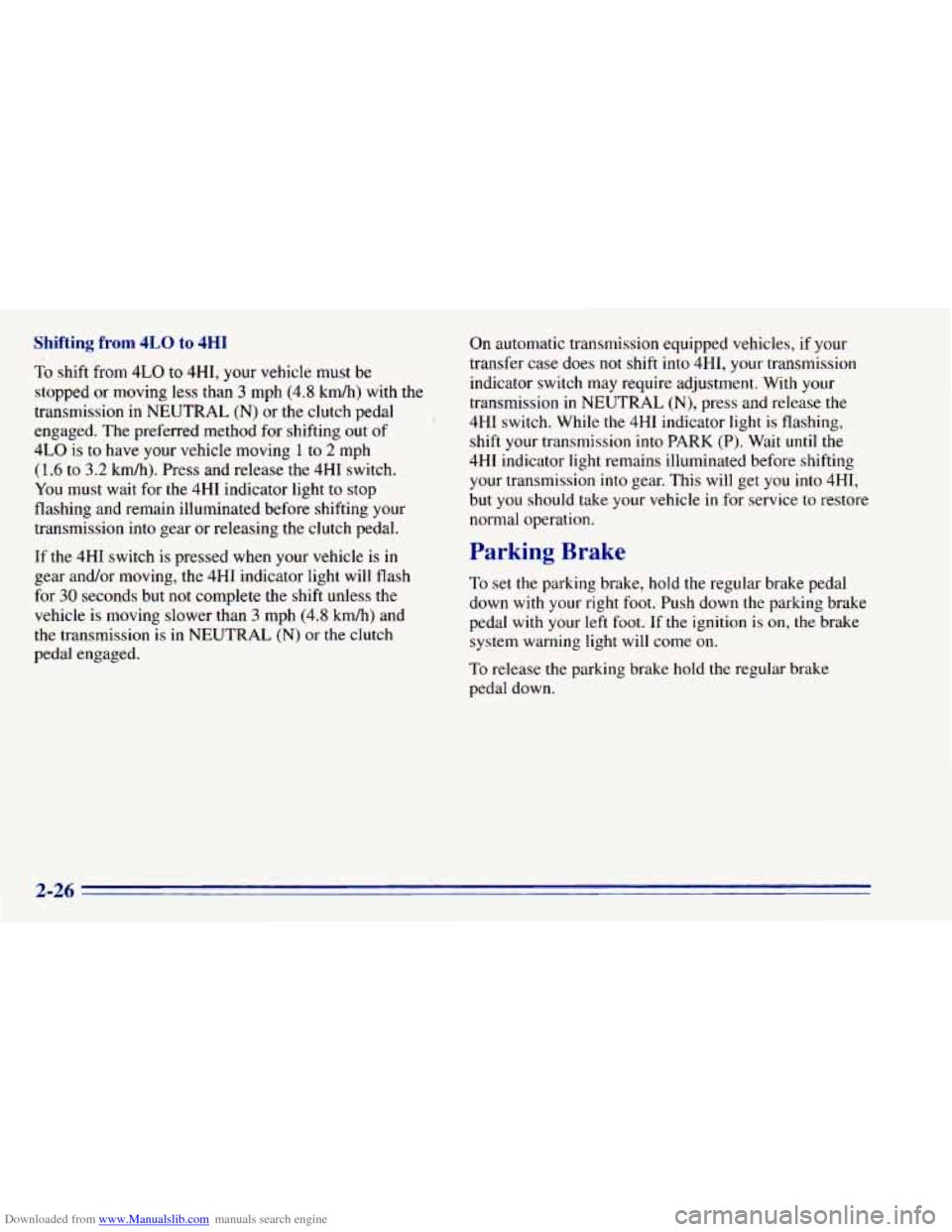
Downloaded from www.Manualslib.com manuals search engine Shifting from 4LO to 4HI
To shift from 4LO to 4H1, your vehicle must be
stopped or moving
less than 3 mph (4.8 km/h) with the
transmission
in NEUTRAL (N) or the clutch pedal
engaged. The preferred method for shifting out
of
4LO is to have your vehicle moving 1 to 2 mph
(1.6 to 3.2 km/h). Press and release the 4HI switch.
You must wait for
the 4HI indicator light to stop
flashing and remain illuminated before shifting your
transmission into gear or releasing the clutch pedal.
If the 4HI switch is pressed when your vehicle is in
gear and/or moving, the 4HI indicator light will flash
for
30 seconds but not complete the shift unless the
vehicle is moving slower than
3 mph (4.8 km/h) and
the transmission is in NEUTRAL
(N) or the clutch
pedal engaged. On automatic transmission equipped vehicles,
if your
transfer case does not shift into 4H1, your transmission
indicator switch may require adjustment. With your
transmission in NEUTRAL
(N), press and release the
4HI switch. While the 4HI indicator light is flashing,
shift your transmission into PARK
(P). Wait until the
4HI indicator light remains illuminated before shifting
your transmission into gear. This will get you into 4H1,
but you should take your vehicle
in for service to restore
normal operation.
Parking Brake
To set the parking brake, hold the regular brake pedal
down with your right foot. Push down the parking brake
pedal with your left foot. If
the ignition is on, the brake
system warning light will come on.
To release
the parking brake hold the regular brake
pedal down.
2-26
Page 124 of 392
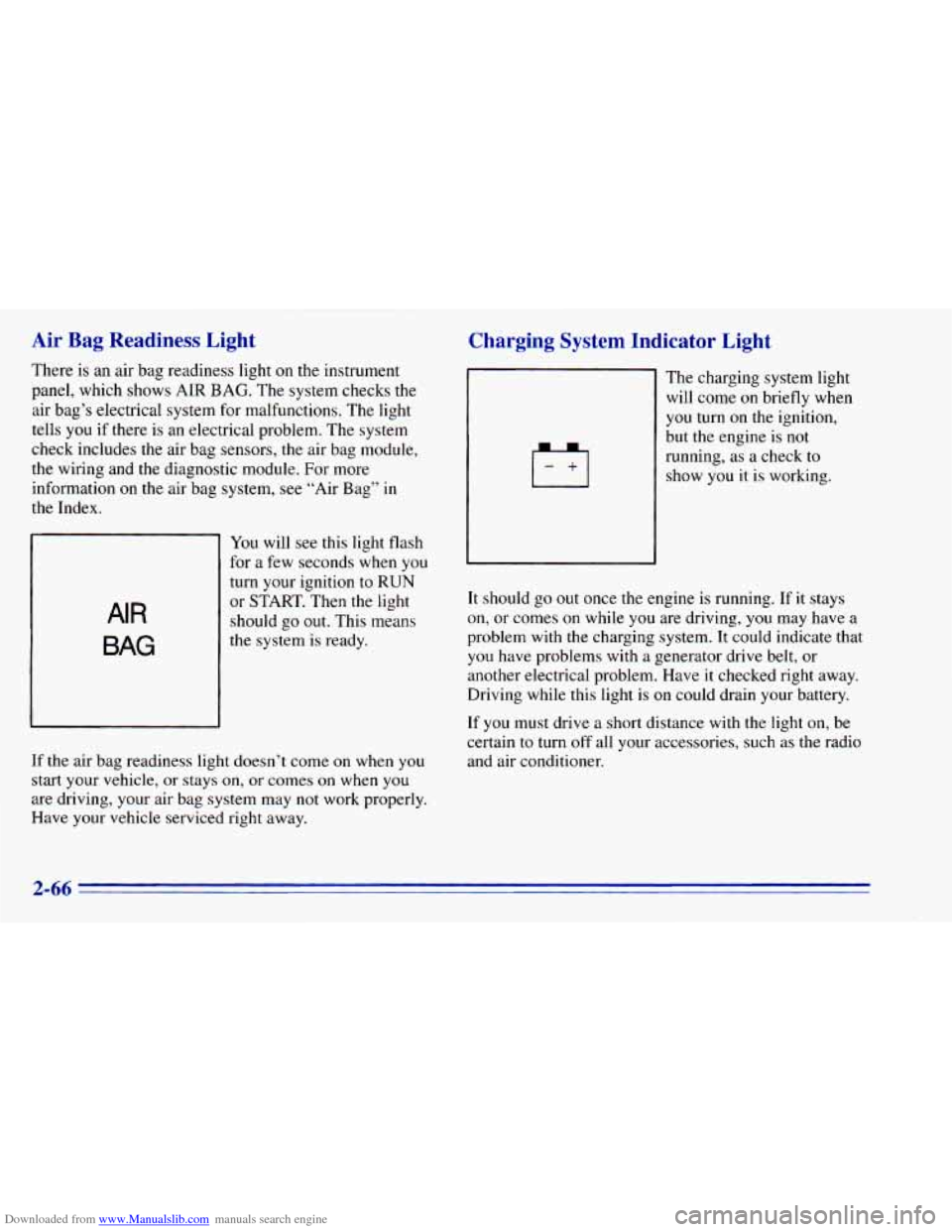
Downloaded from www.Manualslib.com manuals search engine Air Bag Readiness Light
There is an air bag readiness light on the instrument
panel, which shows AIR
BAG. The system checks the
air bag’s electrical system for malfunctions. The light
tells you if there is an electrical problem. The system
check includes the air bag sensors, the air bag module,
the wiring and the diagnostic module. For more
information
on the air bag system, see “Air Bag” in
the Index.
AIR
BAG
You will see this light flash
for a few seconds when you
turn your ignition to RUN
or START. Then the light
should go
out. This means
the system is ready.
If the air bag readiness light doesn’t come on when you
start your vehicle, or stays on,
or comes on when you
are driving, your air bag system may not work properly.
Have your vehicle serviced right away.
Charging System Indicator Light
The charging system light
will come on briefly when
you turn on the ignition,
but the engine is not
running, as a check to
show you it is working.
It should go
out once the engine is running. If it stays
on, or comes on while you are driving, you may have a
problem with the charging system. It could indicate that
you have problems with a generator drive belt, or
another electrical problem. Have it checked right away.
Driving while
this light is on could drain your battery.
If you must drive a short distance with the light on, be
certain
to turn off all your accessories, such as the radio
and air conditioner.
2-66
Page 127 of 392
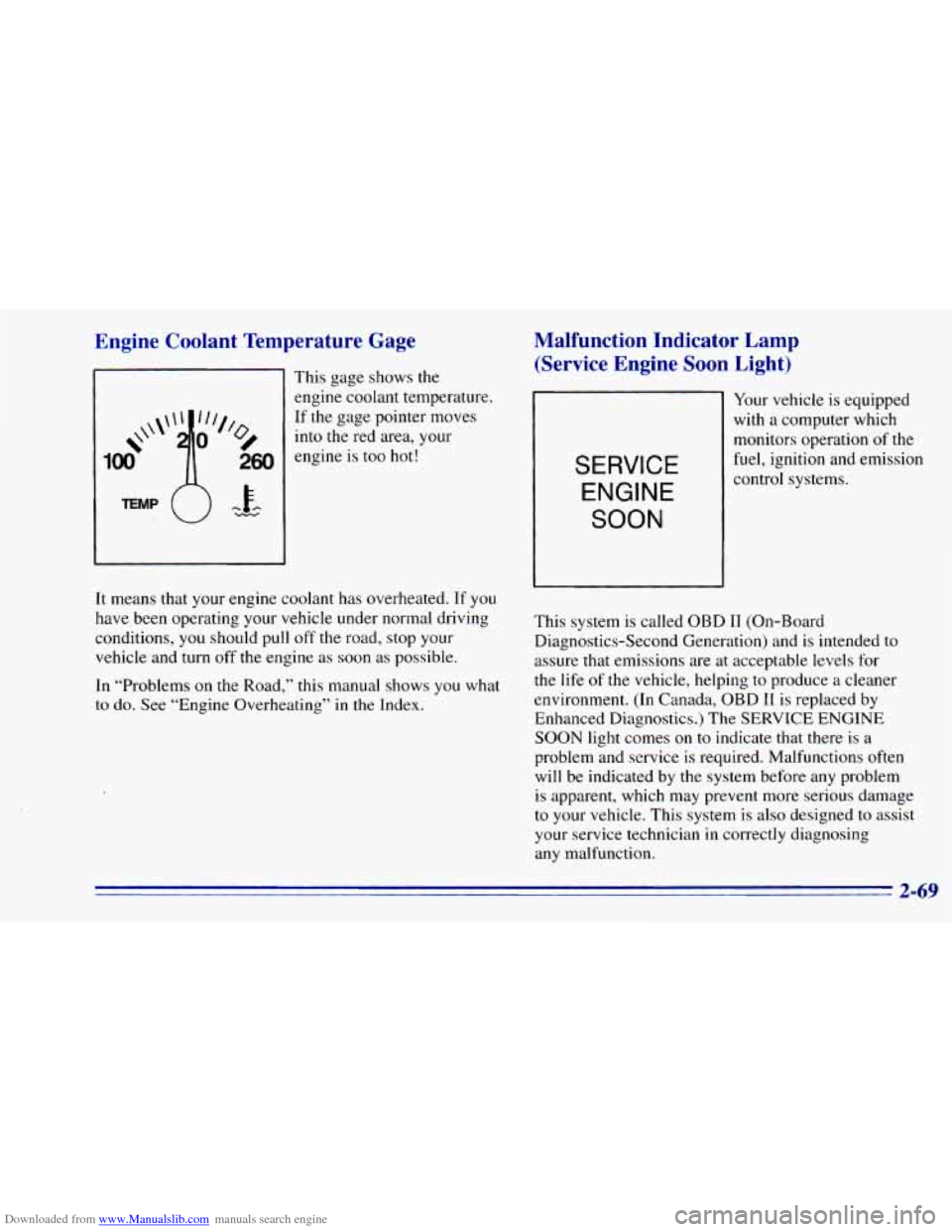
Downloaded from www.Manualslib.com manuals search engine Engine Coolant Temperature Gage
This gage shows the
engine coolant temperature.
If the gage pointer moves
into the red area, your
engine is too hot!
Malfunction Indicator Lamp
(Service Engine Soon Light)
SERVICE
ENGINE
SOON
Your vehicle is equipped
with a computer which
monitors operation
of the
fuel, ignition and emission
control systems.
It means that your engine coolant has overheated. If
you
have been operating your vehicle under normal driving
conditions,
you should pull off the road, stop your
vehicle and turn
off the engine as soon as possible.
In “Problems
on the Road,” this manual shows you what
to do. See “Engine Overheating” in the Index. This
system is called OBD I1 (On-Board
Diagnostics-Second Generation) and is intended to
assure that emissions are at acceptable levels for
the life
of the vehicle, helping to produce a cleaner
environment. (In Canada, OBD
I1 is replaced by
Enhanced Diagnostics.) The SERVICE ENGINE
SOON light comes on to indicate that there is a
problem and service is required. Malfunctions often
will be indicated by
the system before any problem
is apparent, which may prevent more serious damage
to your vehicle. This system is also designed to assist
your service technician
in correctly diagnosing
any malfunction.
2-69
Page 251 of 392
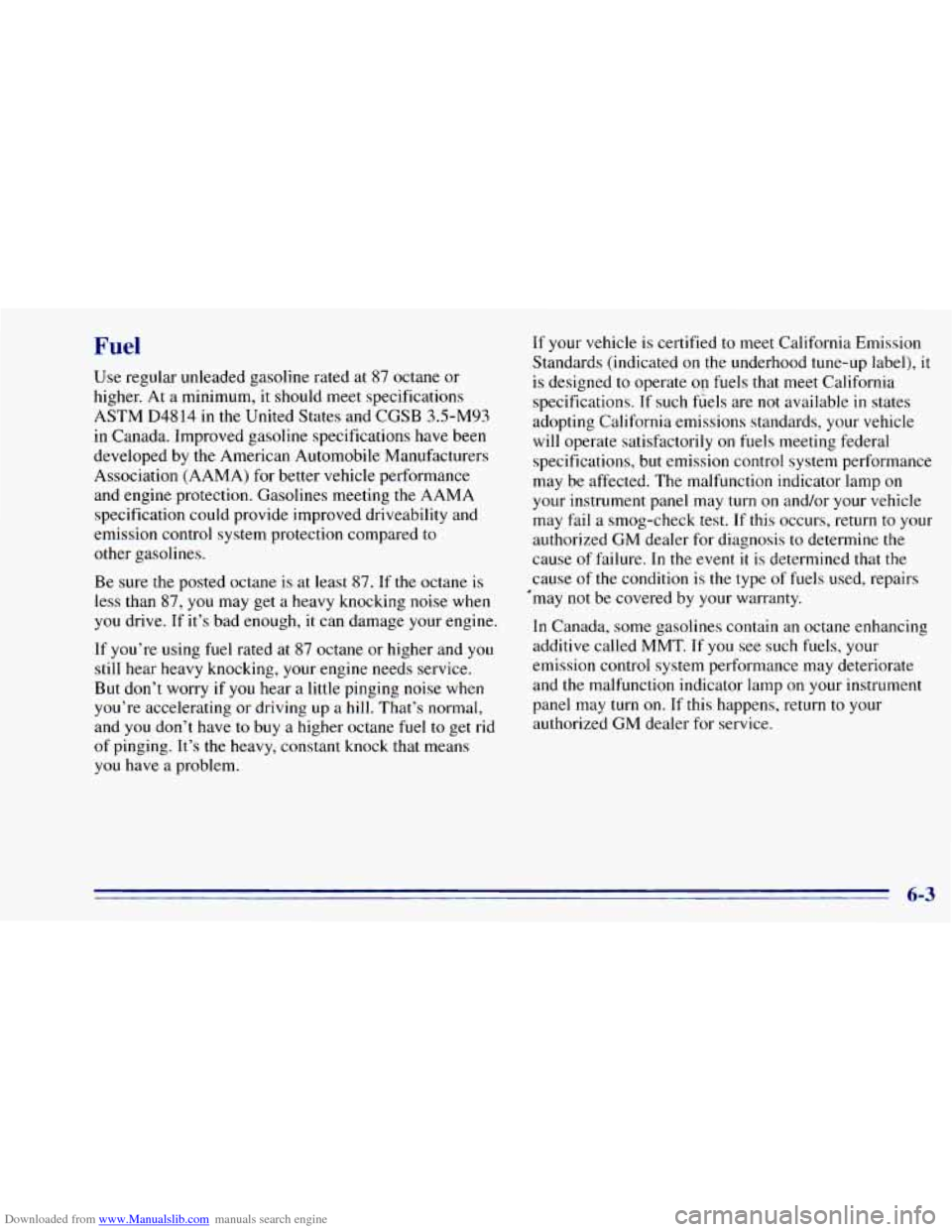
Downloaded from www.Manualslib.com manuals search engine Fuel
Use regular unleaded gasoline rated at 87 octane or
higher. At a minimum, it should meet specifications
ASTM
D4814 in the United States and CGSB 3.5-M93
in Canada. Improved gasoline specifications have been
developed by the American Automobile Manufacturers
Association (AAMA) for better vehicle performance
and engine protection. Gasolines meeting the AAMA
specification could provide improved driveability and
emission control system protection compared to
other gasolines.
Be sure
the posted octane is at least 87. If the octane is
less than
87, you may get a heavy knocking noise when
you drive. If it’s bad enough, it can damage your engine.
If you’re using
fuel rated at 87 octane or higher and you
still hear heavy knocking, your engine needs service.
But don’t worry if
you hear a little pinging noise when
you’re accelerating or driving up a hill. That’s normal,
and
you don’t have to buy a higher octane fuel to get rid
of pinging. It’s the heavy, constant knock that means
you have a problem.
If your vehicle is certified to meet California Emission
Standards (indicated
on the underhood tune-up label), it
is designed to operate og fuels that meet California
specifications. If such fuels are
not available in states
adopting California emissions standards, your
vehicle
will operate satisfactorily on fuels meeting federal
specifications, but emission control system performance
may be affected. The malfunction indicator lamp on
your instrument panel may
turn on and/or your vehicle
may fail a smog-check test. If this occurs, return to your
authorized GM dealer for diagnosis to determine
the
cause of failure. In the event it is determined that the
cause of the condition is the type of fuels used, repairs
‘may
not be covered by your warranty.
In Canada, some gasolines contain an octane enhancing
additive called MMT. If
you see such fuels, your
emission control system performance may deteriorate
and the malfunction indicator lamp
on your instrument
panel may turn on.
If this happens, return to your
authorized GM dealer for service.
6-3
Page 278 of 392
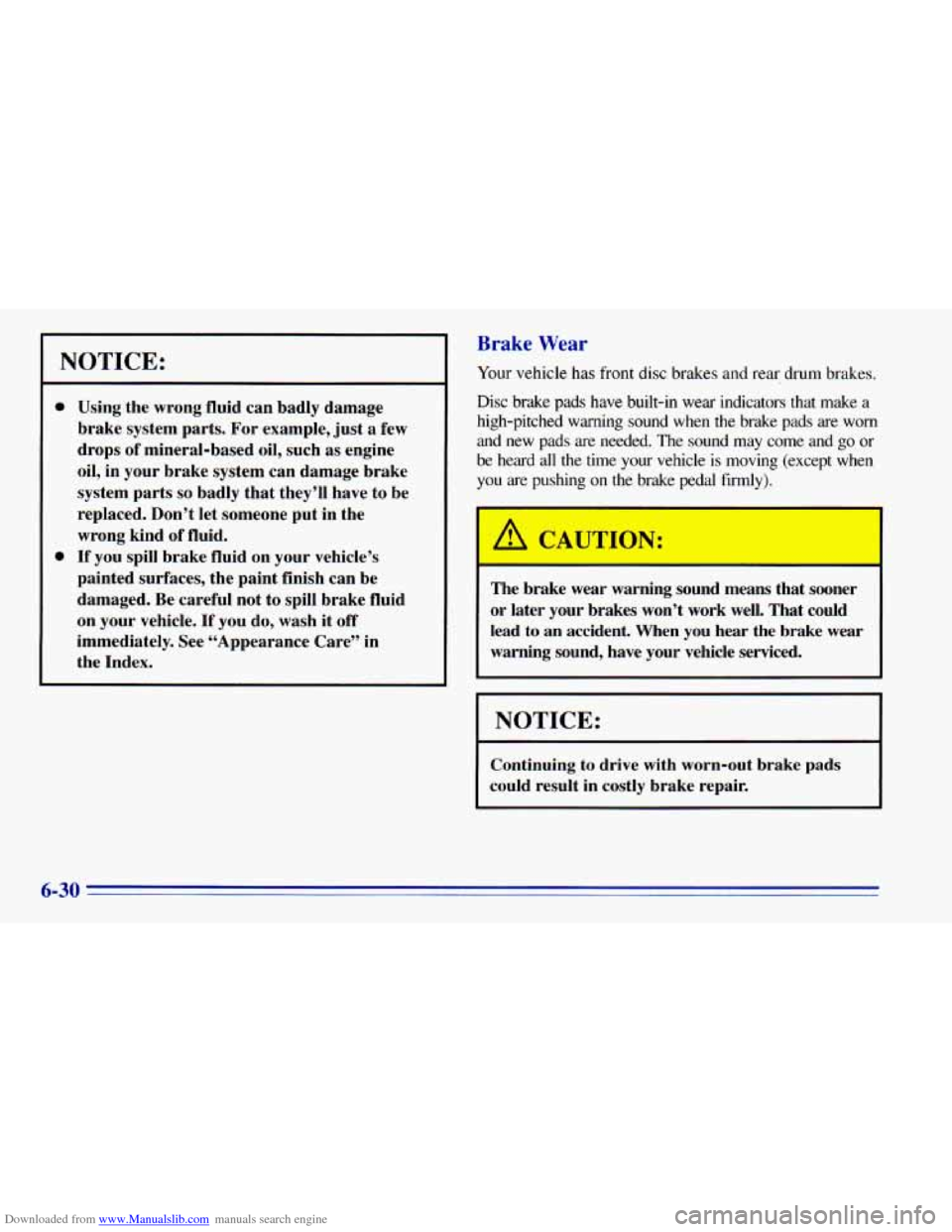
Downloaded from www.Manualslib.com manuals search engine NOTICE:
a
a
Using the wrong fluid can badly damage
brake system parts. For example, just a few
drops
of mineral-based oil, such as engine
oil, in your brake system can damage brake
system parts
so badly that they’ll have to be
replaced. Don’t let someone put in the
wrong kind of fluid.
If you spill brake fluid on your vehicle’s
painted surfaces, the paint finish can be
damaged. Be careful not to spill brake fluid
on your vehicle.
If you do, wash it off
immediately. See “Appearance Care’’ in
the Index.
Brake Wear
Your vehicle has front disc brakes and rear drum brakes.
Disc brake pads have built-in wear indicators that make a
high-pitched warning sound when
the brake pads are worn
and new pads
are needed. The sound may come and go or
be heard all the time your vehicle is moving (except when
you are pushinq
on the brake pedal firmly).
The brake wear warning sound means that sooner
or later your brakes won’t work well. That could
lead
to an accident. When you hear the brake wear
warning sound, have your vehicle serviced.
NOTICE:
Continuing to drive with worn-out brake pads
could result in costly brake repair.
Page 292 of 392
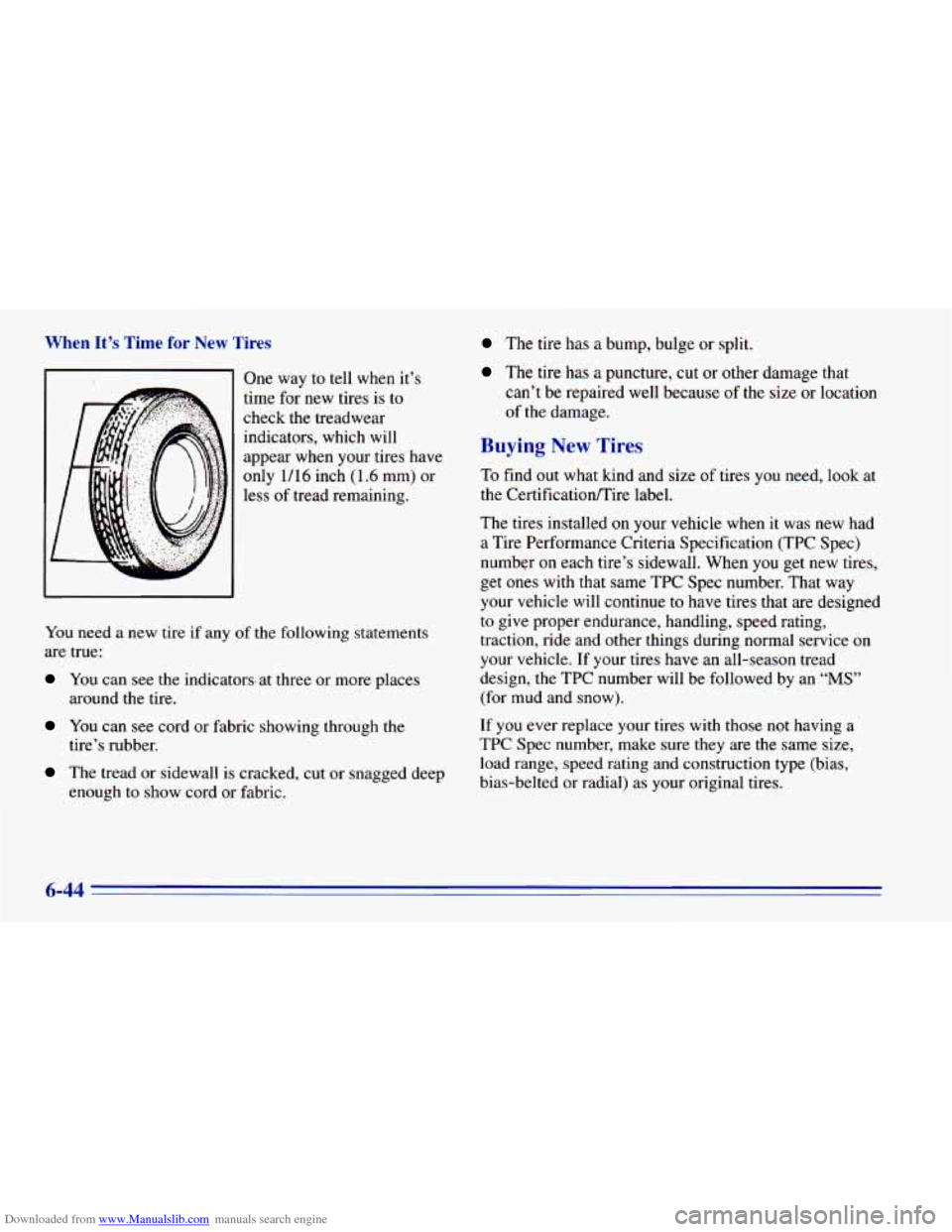
Downloaded from www.Manualslib.com manuals search engine When It’s Time for New Tires
One way to tell when it’s
time for new tires is
to
check the treadwear
indicators, which will
appear when your tires have
only 1/16 inch (1.6 mm) or
less of tread remaining.
You need
a new tire if any of the following statements
are true:
You can see the indicators. at three or more places
around the tire.
You can see cord or fabric showing through the
tire’s rubber.
The tread or sidewall is cracked, cut or snagged deep
enough to show cord or fabric.
The tire has a bump, bulge or split.
The tire has a puncture, cut or other damage that
can’t be repaired well because of the size or location
of the damage.
Buying New Tires
To find out what kind and size of tires you need, look at
the Certificatioflire label.
The tires installed on your vehicle when it was new had
a Tire Performance Criteria Specification (TPC Spec)
number on each tire’s sidewall. When you get new tires,
get ones with that same TPC Spec number. That way
your vehicle will continue to have tires that are designed
to give proper endurance, handling, speed rating,
traction, ride and other things during normal service on
your vehicle. If your tires have an all-season tread
design,
the TPC number will be followed by an “MS”
(for mud and snow).
If you ever replace your tires with those not having a
TPC Spec number, make sure they are the same size,
load range, speed rating and construction type (bias,
bias-belted or radial) as your original tires.
6-44
Page 383 of 392
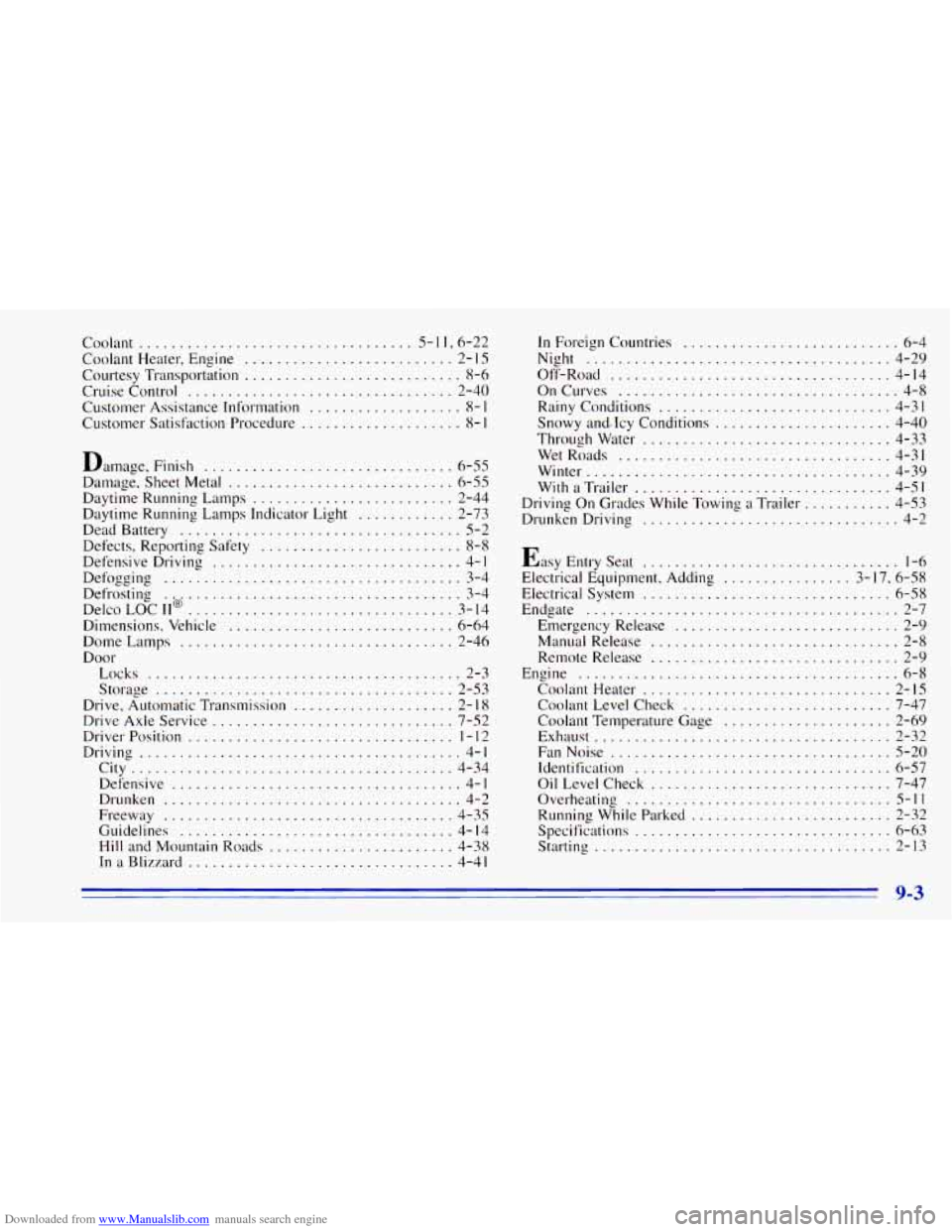
Downloaded from www.Manualslib.com manuals search engine Coolant .............................. 5- 1 1. 6-22
Courtesy Transportation
........................... 8-6
Cruise Control ................................. 2-40
Customer Assistance Information
................... 8- 1
Customer Satisfaction Procedure .................. 8- 1
Coolant Heater. Engine .......................... 2- I5
Damage. Finish ............................... 6-55
Damage. Sheet Metal
............................ 6-55
Daytime Running Lamps
......................... 2-44
Daytime Running Lamps Indicator Light
............ 2-73
Dead Battery
................................... 5-2
Defensive Driving
............................... 4- I
Defogging ..................................... 3-4
Defrosting
................................ 3-4
DelcoLOCII
................................. 3-14
Dimensions. Vehicle
............................ 6-64
Dome Lamps
............ .................. 2-46
Door Defects. Reporting Safety
......................... 8-8
@ **
Locks ....................................... 2-3
Storage
..................................... 2-53
Drive. Automatic Transmission
.................... 2- I8
Drive Axle Service .............................. 7-52
Driver Position
................................. I - 12
Driving ........................................ 4-1
City
........................................ 4-34
Defensive
.................................... 4-1
Drunken
..................................... 4-2
Freeway
.................................... 4-35
Guidelines
.................................. 4- I4
Hill and Mountain Roads ....................... 4-38
InaBlizzard
................................. 4-41
In Foreign Countries ........................... 6-4
Night
...................................... 4-29
Off-Road
................................... 4-14
OnCurves
................................... 4-8
Rainy Conditions
............................. 4-31
Snowy and. Icy Conditions
...................... 4-40
Throughwater
............................... 4-33
Wet Roads
.................................. 4-31
Winter
...................................... 4-39
With a Trailer
................................ 4-51
Driving On Grades While Towing a Trailer
........... 4-53
Drunken Driving
................................ 4-2
Easy Entry Seat
................................ 1-6
Electrical Equipment. Adding
................ 3- 17. 6-58
Electrical System
............................... 6-58
Endgate
....................................... 2-7
Emergency Release
............................ 2-9
ManualRelease
............................... 2-8
Remote Release ............................... 2-9
Coolant Heater
............................... 2-15
Coolant Level Check
.......................... 7-47
Coolant Temperature Gage
..................... 2-69
FanNoise
................................... 5-20
Identification
................................ 6-57
OilLevelCheck
.............................. 7-47
Overheating ................................. 5-11
Specifications ................................ 6-63
Engine
........................................ 6-8
Exllaust
..................................... 2-32
Running While Parked
......................... 2-32
Starting
..................................... 2-13
9-3
Page 385 of 392
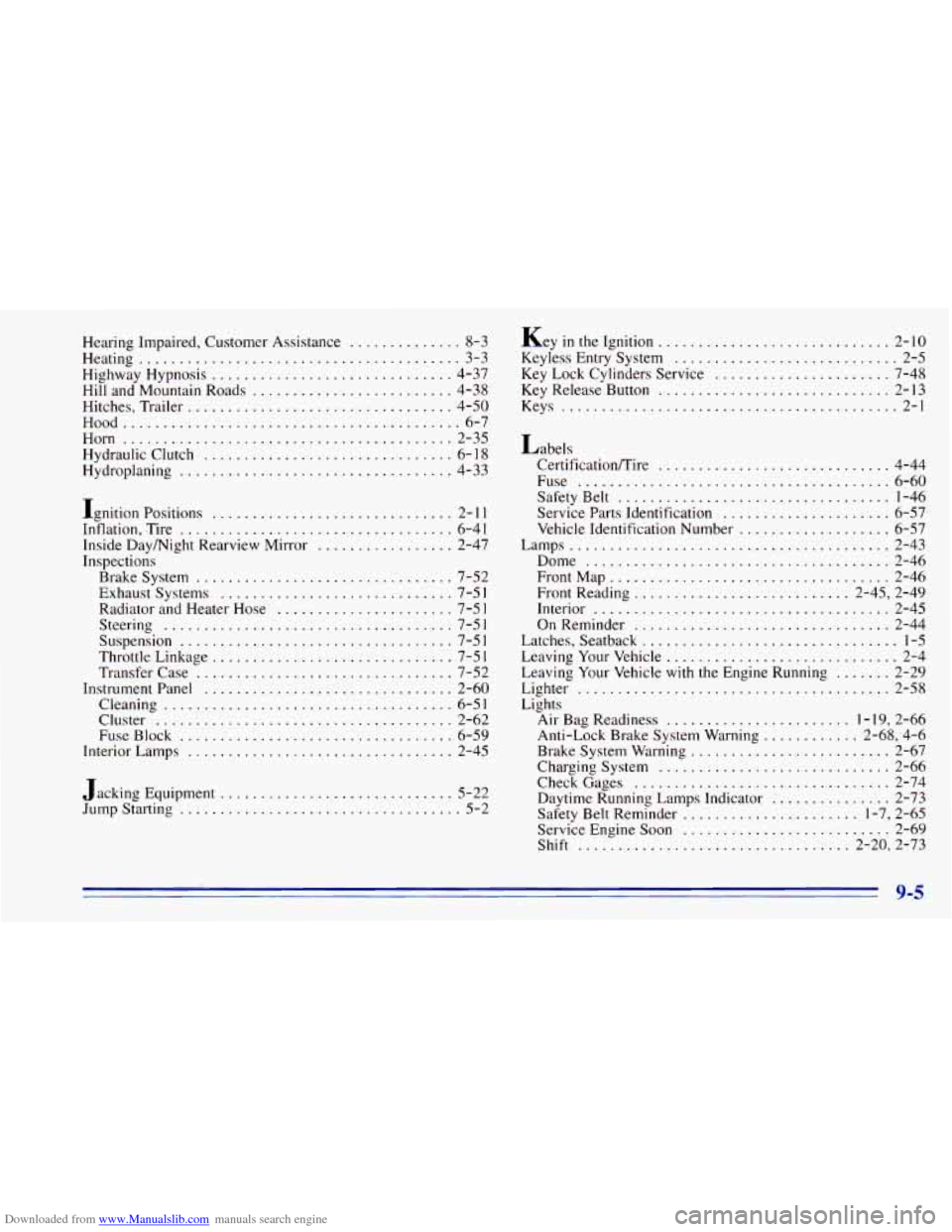
Downloaded from www.Manualslib.com manuals search engine Hearing Impaired. Customer Assistance .......... 8-3
Heating
........................................ 3-3
Highway Hypnosis
.............................. 4-37
Hill and Mountain Roads
......................... 4-38
Hitches. Trailer
................................. 4-50
Horn
......................................... 2-35
Hydraulic Clutch
............................... 6- 18
Hydroplaning .................................. 4-33
Hood
.......................................... 6-7
Ignition Positions
.............................. 2- I I
Inflation. Tire .................................. 6-41
Inside Day/Night Rearview Mirror
................. 2-47
Inspections Brakesystem
................................ 7-52
Exhaust Systems
............................. 7-5 1
Radiator and Heater Hose ...................... 7-51
Steering
.................................... 7-51
Suspension
.................................. 7-51
Throttle Linkage .............................. 7-5 1
Transfer Case ................................ 7-52
Instrument Panel
............................... 2-60
Cleaning
.................................... 6-51
Cluster
..................................... 2-62
FuseBlock
.................................. 6-59
Interior Lamps
................................. 2-45
Jacking Equipment
............................. 5-22
Jump Starting
................................... 5-2
Key in the Ignition ............................. 2-10
Keyless Entry System
............................ 2-5
Key Lock Cylinders Service
...................... 7-48
Key Release Button
.............................
Labels Certificationflire
............................. 4-44
Fuse
....................................... 6-60
Safety Belt
.................................. 1-46
Service Parts Identification
..................... 6-57
Vehicle Identification Number
................... 6-57
Lamps
........................................ 2-43
Dome
...................................... 2-46
FrontMap
................................... 2-46
Front Reading
........................... 2.45, 2.49
Interior
..................................... 2-45
OnReminder
................................ 2-44
Latches. Seatback
................................ 1-5
Leaving Your Vehicle ............................. 2-4
Leaving Your Vehicle
with the Engine Running ....... 2-29
Lights
Lighter
....................................... 2-58
Air Bag Readiness ....................... 1-19,
2-66
Anti-Lock Brake System Warning
............ 2-68. 4-6
Brake System Warning
......................... 2-67
Charging System
............................. 2-66
Daytime Running
Lamps Indicator ............... 2-73
Safety Belt Reminder
...................... 1-7, 2-65
Service Engine Soon
.......................... 2-69
Shift
.................................. 2-20. 2-73
CheckGages ................................ 2-74
9-5
Page 386 of 392
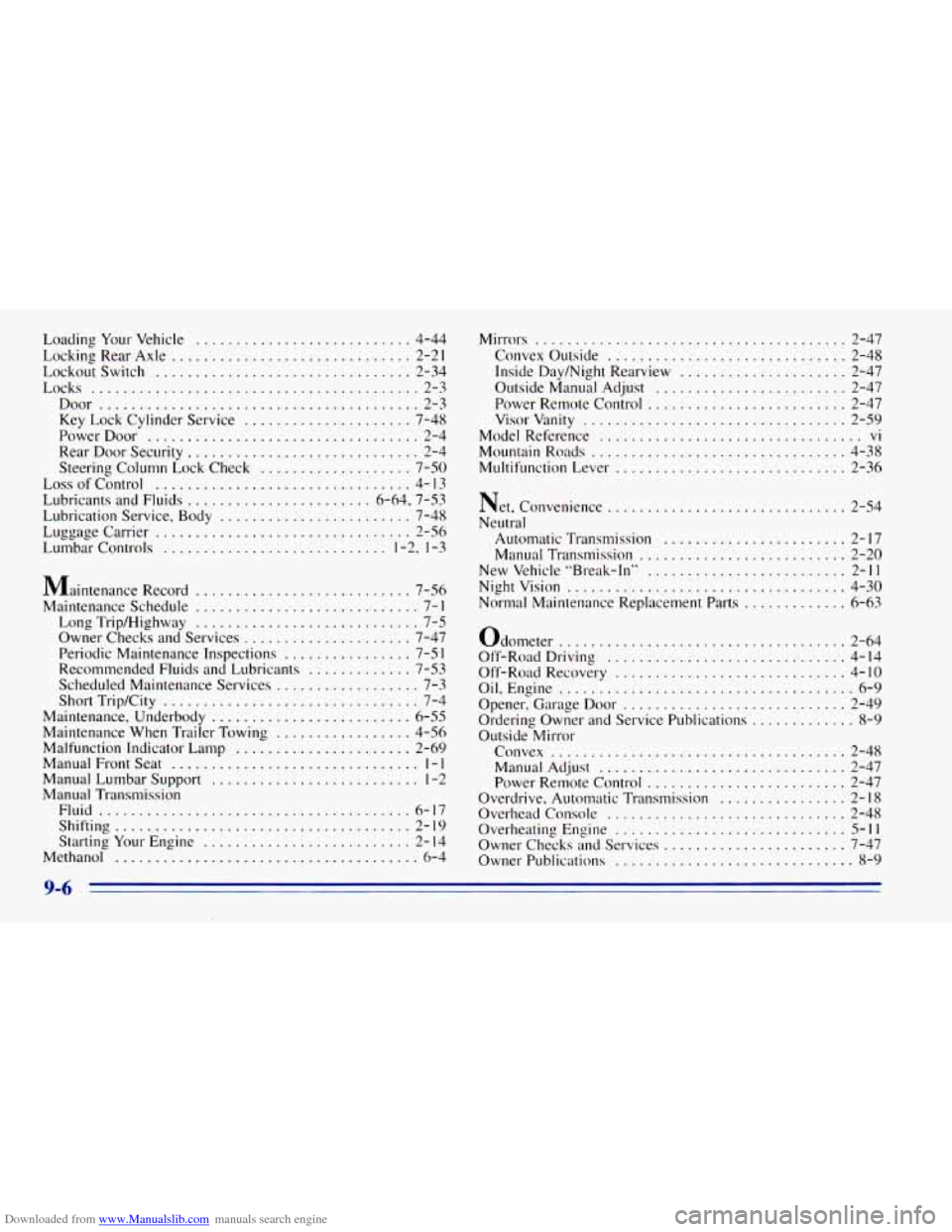
Downloaded from www.Manualslib.com manuals search engine Loading Your Vehicle ........................... 4-44
Locking Rear Axle
.............................. 2-2 1
Lockoutswitch ................................ 2-34
Locks
......................................... 2-3
Door
........................................ 2-3
Key Lock Cylinder Service
..................... 7-48
PowerDoor
.................................. 2-4
Rear Door Security
............................. 2-4
Steering Column Lock Check
................... 7-50
Loss
of Control ................................ 4- I3
Lubricants and Fluids ....................... 6.64. 7.53
Lubrication Service. Body
........................ 7-48
Luggagecarrier
................................ 2-56
Lumbar Controls
............................ 1.2 . 1-3
Maintenance Record ........................... 7-56
Maintenance Schedule
............................ 7- 1
Long Trip/Highway ............................ 7-5
Owner Checks and Services
..................... 7-47
Periodic Maintenance Inspections
................ 7-5 1
Recommended Fluids and Lubricants ............. 7-53
Scheduled Maintenance Services
.................. 7-3
Short Trip/City
................................ 7-4
Maintenance. Underbody
......................... 6-55
Maintenance When Trailer Towing ................. 4-56
Malfunction Indicator Lamp
...................... 2-69
ManualFrontSeat
............................... 1-1
Manual Lumbar Support .......................... 1-2
Manual Transmission
Fluid
..................................... 6-17
Shifting
........................... ..... 2-19
Starting Your Engine
.............. ... 2-14
Methanol
...................................... 6-4 Mirrors
....................................... 2-47
Convex Outside
.............................. 2-48
Inside Day/Night Rearview ..................... 2-47
Power Remote Control
......................... 2-47
Visorvanity
................................. 2-59
Model Reference
................................. vi
Mountain Roads ................................ 4-38
Multifunction Lever
............................. 2-36
Net. Convenience
.............................. 2-54
Neutral Automatic Transmission
....................... 2-17
Manual Transmission
.......................... 2-20
New Vehicle “Break-In”
......................... 2-11
Nightvision ................................... 4-30
Normal Maintenance Replacement Parts
............. 6-63
Outside Manual Adjust
........................ 2-47
Odometer
.................................... 2-64
Off-Road Driving
.............................. 4-14
Off-Road Recovery
............................. 4- IO
Oil. Engine ..................................... 6-9
Opener. Garage Door
............................ 2-49
Ordering Owner and Service Publications
............. 8-9
Outside Mirror Convex
..................................... 2-48
Manual
Adjust ............................... 2-47
Power Remote Control
......................... 2-47
Overdrive. Automatic Transmission
................ 2-18
Overhead Console
.............................. 2-48
Overheating Engine
............................. 5-11
Owner Checks and Services ....................... 7-47
Owner Publications
.............................. 8-9
9-6